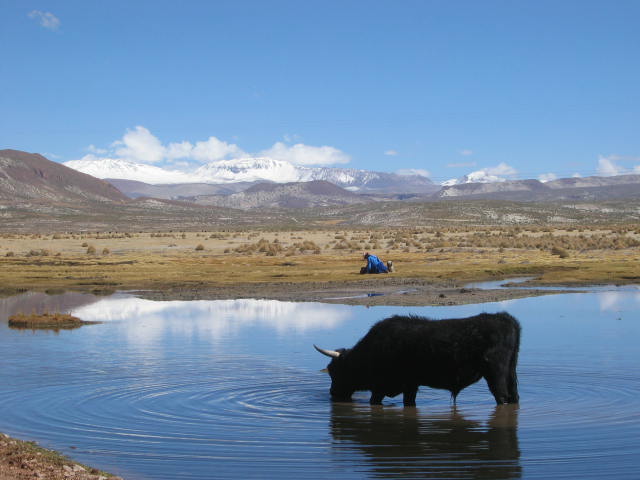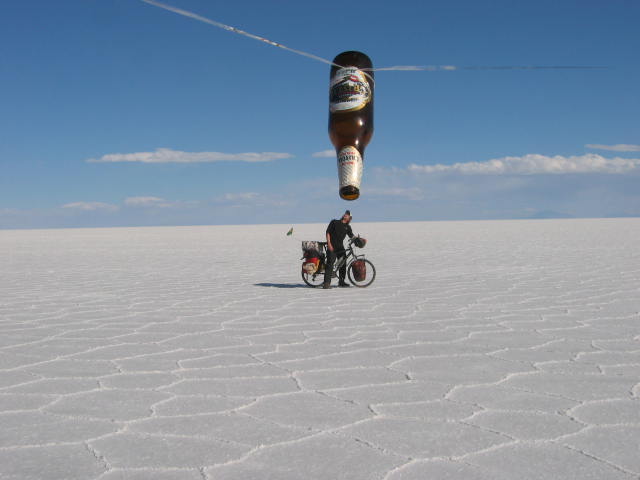Please visit Ryan Parton Writing Solutions, Comox Valley copy writer
The following are stories written for the Selkirk Journal and the Comox Valley Record during my 11-month bicycle expedition through South America, from January to November, 2004:
Border Bound (a pre-trip introduction)
Against the Wind Through Tierra del Fuego
Hurry Up and Slow Down (cycling in Patagonia)
Chugging Through Chile (cycling Chile's Carretera Austral)
Argentina a Lot Like Canada (crossing the Argentina pampas)
South America's Hidden Gem (travels in Uruguay)
The Bolivian Paradox
Pushing Through Peru (misadventures on a Peruvian riverboat)
Jungle Journey a Drag (cycling the Brazilian Amazon
Grand Finale (cycling Venezuela)
Back to my writing samples
Back to Atravesando Fronteras home page

 The Bolivian Paradox
The Bolivian Paradox
by Ryan Parton
I leaned heavily on my handlebars, gasping uncontrollably in spasmic bursts as my lungs tried frantically to fill themselves with the thin Andean air. As my my heart jackhemmered up in my throat, all I could think of were the three ominous words that had greeted me from a colourful billboard a few short days before: "Welcome to Bolivia."
Bolivia, the sixth country of my trans-South American bike trip, offers everything the bicycle tourist craves: Wide open spaces, beautiful mountain scenery and plenty of opportunities to get well off the beaten path. The paradox, however, is that Bolivia is also rife with all the things the bicycle tourist loathes, from gruelling climbs at oxygen-starved altitudes, to roads so rough you wonder why you didn´t just stay at home and beat yourself in the ass with a paddle, and save yourself the dust shower.
My love/hate relationship with Bolivia began in the pretty little city of Potosí which, at an altitude of more than 4,000 metres, is the highest city of its size in the world. Although my plan was to spend three days of rest acclimatising to the thin mountain air, I instead spent my time exploring the city’s crowded narrow streets and, more interestingly, the abysmal working conditions of the nearby mines, the real reason Potosí exists at all.
The miners of Cerro Rico, the nearly perfect, rust-coloured cone that looms over Potosí, begin working in the dark, cramped shafts as young as 11 years old. Temperatures in the mines range from below freezing to up to 45 degrees, and yet the miners stay underground for up to 12 hours a day, tapping the ore for tin, lead and the famous silver that once made Potosí the largest and wealthiest city in the new world. For his troubles, the average miner earns two to three dollars a day, and generally dies within 15 years of initially entering the mine, according to one guidebook.
Perhaps it was because I spent my acclimatisation time stooping around in dank mine shafts that I found myself in the aforementioned state of near collapse halfway up my first Bolivian hill, about 20 minutes out of Potosí. When my hyperventilations finally eased and I was able to regain some semblance of composure, I scanned the stark beauty of the Andean landscape through which I was slowly passing. In all directions the horizon rose and fell with the erratic contours of jagged peaks, framed under a sky so blue you’d swear it had been digitally enhanced. Energised by the powerful serenity of the scene, I stubbornly pushed on.
At the end of my first day out of Potosí I arrived at the tiny mining town of Agua Castillo, where I was constantly surrounded by a swarm of curious children, some asking about my trip, others asking for money or sweets and several more just staring dumbly at the rare, lycra-clad specimen that had just rolled into their midst. The following morning I packed up as quickly as I could, eager to escape the silent yet intrusive stares of the small crowd that had gathered in the elementary school classroom in which I´d spent the night.
Excited to be out again on my own, I was even more excited to discover that the road generally wound its way downhill, precariously hugging the edge of a blood-red canyon that reminded me of the one into which Wile E. Coyote repeatedly plummeted in the old roadrunner cartoons. A great day of riding culminated with another arduous climb to the top of a high pass, where I camped for the night under a fickle sky that alternately showed me stunning starscapes and flurries of light, driving snow. I don’t think I’ve ever felt so alone as I did that evening, sitting on the rocks eating a home-made satay pasta, and yet with the mountains as my silent companions, I was never lonely.
I continued on the next morning, down a long winding descent to the village of Tica Tica, where I was chased by grubby children yelling "Gringo, plata, gringo plata!," and onwards following a dry river bed flanked by pastured where grazed llamas, a few sheep and the occasional cow. Although I was thankful for the relatively flat terrain, the road, already littered with fist-sized rocks, took a dramatic turn for the worse once I past tica Tica. It was the worst road surface I’ve ever cycled, covered with the two most efficient momentum-suckers known to cyclists: Sand and washboard. With my hands aching from the constant jolts, and cursing loudly at whoever wasn’t around to listen, I managed to make it more than 70 kilometres along this ugly road, and up another steep hill that nearly killed me, to the semi-abandoned mining town of Pulacayo.
 Beautifully perched atop an outcrop of red rock speckled with hardy tufts of green alpine grass, I found Pulacayo to be a pleasant, very interesting town. In the late 17th century, Pulacayo was the site of Bolivia´s first mine, and the rusting engines of the country´s first trains, imported form England and the United States to haul the ore, are still on distplay in the town´s front plaza. In its heyday, Pulacayo was home to upwards of 50,000 people, but its population has since eroded to only a few hundred. Nonetheless, the town retains most of its buildings that were used to house the previous masses, giving the town an eerie, deserted feel.
Beautifully perched atop an outcrop of red rock speckled with hardy tufts of green alpine grass, I found Pulacayo to be a pleasant, very interesting town. In the late 17th century, Pulacayo was the site of Bolivia´s first mine, and the rusting engines of the country´s first trains, imported form England and the United States to haul the ore, are still on distplay in the town´s front plaza. In its heyday, Pulacayo was home to upwards of 50,000 people, but its population has since eroded to only a few hundred. Nonetheless, the town retains most of its buildings that were used to house the previous masses, giving the town an eerie, deserted feel.
After a night in an abandoned hotel in Pulacayo, I finally arrived early the next day in Uyuni, a bit of a dustbowl of a town surrounded by brown fields littered with tattered plastic bags and heaps of rusting scrap metal. Uyuni´s main draw is the nearby Salar de Uyuni, the largest and, at 3,650 metres, highest salt flat in the world. As I intended to cross the Salar by bicycle, I ignored the myriad touts promoting 4 x 4 excursions and, after a night of rest and well-deserved pizza, set out toward the great white expanse beckoning on the horizon.
The first stop before actually entering the Salar is the village of Colchani, about 20 kilometres north of Uyuni and home to about 150 people. Here, about 2,000 kilograms of salt per day is harvested from the Salar, first scraped into small conical mounds and then collected, refined and shipped throughout Bolivia, and even internationally, ready for human consumption. Apparently the salt business isn’t as illustrious as it once was, however, for Colchani´s nearly deserted streets are dominated by the crumbling ruins of abandoned homes and littered with forgotten trash, earning Colchani the unfortunate honour of being the ugliest town I’ve ever seen.
In contrast, the Salar de Uyuni is surely one of the most amazing and unique places on the globe. The result of repeated evaporating and re-flooding of a massive ancient lake, the Salar de Uyuni is 12,000 square kilometres of flat, blindingly white salt, an estimated 10 billion tons of it, naturally arranged into roughly hexagonal blocks that lend it a fascinating, entirely otherworldly appearance.
In the centre of the Salar the impressive, cactus-studded Isla Incahuasi rises defiantly from the silent white sea. Camping under the stars and the towering cacti on the "shores" of Incahuasi is an experience I won’t soon forget.
Forty kilometres north of Isla Incahuasi, on the edge of the great white void, sits the minuscule village of Jirira, where I spent three nights after my crossing of the Salar in the company of the first overtly friendly Bolivians I’ve met. Due to heavy rains which made the sandy roads nearly impassable, I travelled on a rickety bus along with my new Bolivian friends, several dead and skinned pigs, a small dog and a baby lamb in a llama-wool sweater to the city of Oruro. From here I will travel north to the Bolivian capital of La Paz to meet a new cycling partner, a friend flying down from Canada, with whom I´ll traverse the Peruvian Andes and eventually descend into the steamy Amazon basin, where awaits a whole new climate and a whole new adventure.

Next
Previous
Border Bound (a pre-trip introduction)
Against the Wind Through Tierra del Fuego
Hurry Up and Slow Down (cycling in Patagonia)
Chugging Through Chile (cycling Chile's Carretera Austral)
Argentina a Lot Like Canada (crossing the Argentina pampas)
South America's Hidden Gem (travels in Uruguay)
The Bolivian Paradox
Pushing Through Peru (misadventures on a Peruvian riverboat)
Jungle Journey a Drag (cycling the Brazilian Amazon
Grand Finale (cycling Venezuela)
Back to my writing samples
Back to Atravesando Fronteras home page
 Beautifully perched atop an outcrop of red rock speckled with hardy tufts of green alpine grass, I found Pulacayo to be a pleasant, very interesting town. In the late 17th century, Pulacayo was the site of Bolivia´s first mine, and the rusting engines of the country´s first trains, imported form England and the United States to haul the ore, are still on distplay in the town´s front plaza. In its heyday, Pulacayo was home to upwards of 50,000 people, but its population has since eroded to only a few hundred. Nonetheless, the town retains most of its buildings that were used to house the previous masses, giving the town an eerie, deserted feel.
Beautifully perched atop an outcrop of red rock speckled with hardy tufts of green alpine grass, I found Pulacayo to be a pleasant, very interesting town. In the late 17th century, Pulacayo was the site of Bolivia´s first mine, and the rusting engines of the country´s first trains, imported form England and the United States to haul the ore, are still on distplay in the town´s front plaza. In its heyday, Pulacayo was home to upwards of 50,000 people, but its population has since eroded to only a few hundred. Nonetheless, the town retains most of its buildings that were used to house the previous masses, giving the town an eerie, deserted feel. The Bolivian Paradox
The Bolivian Paradox